World Handicraft Day
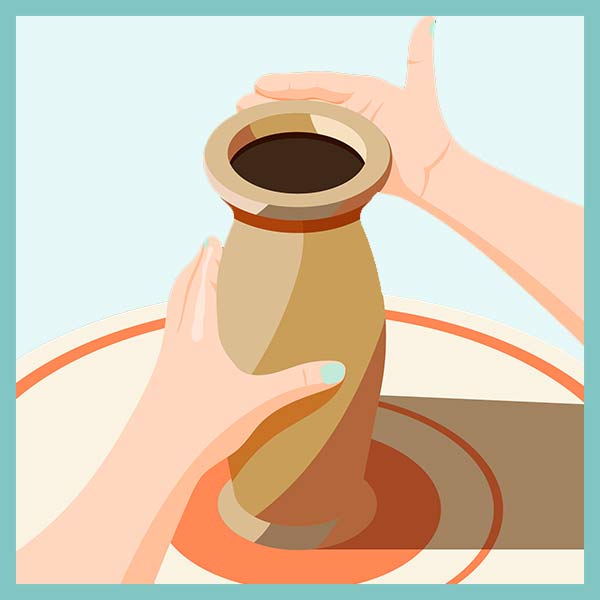
روزِ جَهانیِ صَنایعِ دَستی
امروز، دَهمِ ژوئن، بیستِ خُرداد، به عنوانِ روزِ جَهانیِ صَنایعِ دَستی در سراسرِ جهان جَشن گرفته می شود. این روز تَوسُطِ شورایِ جهانیِ صَنایِعِ دَستی اِنتخاب شده است. این شورا بیش از نیم قَرنِ پیش، با هدفِ معرفی صَنایِعِ دَستی، اِرتقایِ جایگاهِ آنها، شِناسایی و حِمایت از هُنرمندان و اِرائه یِ بَرنامه های حِمایتی، آموزشی، و مالی شروع به فَعالیَّت کرده است. این شورا هم اکنون بیش از 90 عُضو دارد و دَبیرخانه ی آن در شَهر آمستِردام واقِع شده است. ایران نیز در سال 1347 به عُضویَتِ این شورا دَرامده است و در حالِ حاضِر از اَعضایِ فَعّال و مُهمِ آن مَحسوب می شود.
.
World Handicraft Day
Today, June 10, is celebrated all over the world as World Handicraft Day. This day was selected by the World Crafts Council. This council has been established almost half a century ago to introduce world handicrafts, foster economic development of the handcrafts, find the artists and support them, and offer supportive, educational, and financial programs. The council which is located in Amsterdam has 90 members. Iran joined this council in 1968 and has been an active and significant member since then.
اَهَمیتِ روزِ صنایعِ دستی
چرا این روز برایِ ما در فارسیموند وبرای فارسی آموزان مُهم است؟ دَلیل اول اینکه صَنایعِ دستیِ هر کشور برگرفته از فَرهَنگ، هُنر و بینشِ مردُمِ آن مَنطَقه است و در ساختِ آن از مَواد بومیِ همان نَواحی اِستفاده می شود. آشنا شدنِ فارسی آموزان با صَنایعِ دستیِ ایران، به آنها کُمک می کند تا هرچه بیشتر با فَرهنگ و طَرزِ فکرِ ایرانی ها آشنا شَوند تا دَرکِ بهتری از زبان فارسی داشته باشند. دلیلِ دیگر اینکه خَرید و فروشِ صَنایعِ دستیِ هر کِشور و مُعرفیِ آنها به دوستان و آشنایان، می تواند به تَبادل و پیوندِ فَرهنگی میانِ کشورها کُمک کند. یکی از اهدافِ مهمِ ما در فارسیموند این است که پُلی میانِ فَرهنگ های گوناگون باشیم. صُحبت کردن دَرباره ی صَنایعِ دَستی هر مَنطقه به مُدَرِسان و فارسی آموزان کُمک می کند که به روشی جَذاب با هُنر و زیبایی هایِ شهرها و مَناطقِ مُختَلف ایران و جَهان آشنا شَوند.
دلیلِ آخر اینکه ایران، به عُنوان یک تَمَدُنِ باستانی، دارایِ مَجموعه ای از شاخِص ترین صَنایعِ دَستی است که این آثار ریشه هایِ عَمیقی در فَرهَنگ و تَمَدُنِ چند هِزارساله ی این سَرزمین دارد. در سازمانِ جَهانیِ یونسکو بیش از 600 صَنعتِ دَستی ثَبت شده است که نیمی از آنها در ایران وُجود دارند. عَلاوه بر این، ایران با 14 شَهر بیشترین تِعدادِ شَهرهایِ ثَبت شده در شورایِ جَهانیِ صَنایعِ دَستی را دارد که بیانگَرِ گوناگونی، گُستَردِگی و قِدمَتِ صَنایِعِ دستی در پهنه فلاتِ ایران است. مثلاً تبریز، شَهرِ جَهانیِ فَرش، مَشهَد، شَهرِ جَهانیِ گوهَرسَنگ ها، لاله جین، شَهر جهانیِ سُفال، از شَهرهایِ شِناخته شُده ی ایران در زمینه یِ صَنایِعِ دَستی هستند. دو شهرِ اِصفهان و شیراز نیز به دَلیل تَنَوُعِ بِسیار بالا، گُستردِگیِ آن میانِ مردم و زنده بودن و پویایی بازار صَنایعِ دستی شان در عَصرِ حاضر به عُنوانِ شَهرِ خَلاقِ صَنایعِ دَستی و شَهرِ جَهانیِ صَنایِعِ دَستی اِنتخاب شُده اند.
The importance of World Handicraft Day
Why Handicraft Day is so important for Farsi teachers in FarsiMonde and Farsi learners? First of all, every country’s handicraft is rooted in the region’s culture, art, and people’s insights. Therefore, getting familiar with Iran’s handicrafts will help Farsi learners to know more about Iran’s culture and the Iranians’ way of thinking to have a better understanding of Farsi. Moreover, buying a country’s handicrafts and introducing them to friends and relatives back in someone’s country can lead to cultural exchange and connection. One of the most important goals of FarsiMonde is to be a bridge between different cultures. We believe that speaking about each region’s handicrafts helps Persian teachers and learners to find out more about art and the beauty of different cities in Iran and the world.
Finally, Iran as an ancient civilization has a significant collection of prominent handicrafts which are rooted in the salient culture of thousands of years. UNESCO has registered more than 600 handicrafts around the world, almost half of which can be found in Iran. Moreover, 14 cities in Iran have been registered by World Crafts Council, the most registered cities in one country. This demonstrates how important handicrafts are and used to be in Iran. For instance, Tabriz the world city of carpets, Mashhad the world city of precious stones, and Lalejin the world city of clay is some of the well-known Iranian cities in handicrafts production. Moreover, Isfahan and Shiraz are chosen as the world city of creativity and the world city of handicrafts respectively due to the high variety of handicrafts in these two cities, the prevalence of using handicrafts among people, and their dynamic markets.
If you want to learn more about Persian Handicrafts in Iranian Souvenirs you can find a lot of useful expressions Here.
صنایعِ دستی در ایران
از نَظرِ سازمانِ میراثِ فرهنگی و صَنایِعِ دَستیِ ایران بیش از 370 رشته ی هُنرهایِ دَستی در 24 دَسته یِ کُلی وُجود دارد. از مُهم ترین آنها می توان به سُفالگری، نَمدبافی، شیشه گَری، مُنَبَت کاری، خاتم کاری، حَصیر بافی، مُعرق کاری اشاره کرد. در این متن، توضیحِ کوتاهی درباره ی چَند نِمونه از صَنایعِ دَستی مُهم در ایران می خوانید. گروه فارسیموند برای فارسی آموزان علاقه مند به هُنرهایِ ایرانی صَفحه ای با نامِ صَنایعِ دستیِ ایرانی دارد.
.
Handicrafts in Iran
Iran Cultural Heritage, Handicrafts, and Tourism Organization categorized 370 art fields into 24 main parts including pottery, felt weaving, glasswork, marquetry, khatam, wicker weaving, and mosaic. In this article, you can read a brief explanation of Iran’s main handicrafts. FarsiMonde group has also provided a page under the name of Iran’s handicrafts for those Persian learners who are interested in Iranian art.
فَرش یا بافته های داری ایرانی
قِدمَتِ فَرش بافی دَستِ کَم به 500 سال پیش از میلاد بَرمی گَردَد و اَنواعِ مُختَلفی مانندِ زیلو، گلیم، قالی و غیره را شامِل می شود. در فَرش های ایرانی معمولاً نَقش و نِگاره هایی مانند تَصاویرِ پَرندِگان و گیاهان و یا تَصاویری اِنتزاعی بافته می شوند. مَوادِ اولیه برای تَهیّه یِ نَخ اَبریشم، پَشم یا پَنبه هَستند که با رنگ های طبیعی رَنگ شُده اند. فَرش تَقریباً در هَمه ی شَهرهایِ ایران بافته می شَود، اما شَهر تبریز به عُنوان شهر جَهانیِ فَرش و شَهرِ کاشان به دَلیلِ مَهارتِ قالی بافی در یونِسکو به ثَبت رسیده اند.
Carpet Weaving
Carpet weaving is an old art dating back to 500 BC. Zilu, gelim, and rug (qâli) are among the various types of carpets. Motives and designs in Iranian carpets are either birds and flowers or abstract images. The threads for weaving carpets are natural and usually made of wool, silk, or cotton which are colored naturally. Carpet weaving is a trend in almost all cities of Iran but Tabriz and Kashan are two UNESCO registered cities. While the former carries the title of world carpet city, the latter is known for adroitness in carpet weaving.
میناکاری
میناکاری هنری است که در آن روکِش های لُعابی با نَقش های زیبا و پرجزئیات به کُمکِ آتش و در دَمایی بالا بر ظروف مِسی نَقش می بَندَد. البته به غیر از مس به صورت محدود ظروفی از جنس طلا ، نقره یا سُفال نیز گاهی در میناکاری اِستفاده می شَوند. قِدمت این هنر نیز به بیش از 2500 سال پیش و دوره هخامنشیان باز می گردَد. نِشانه هایی از فَراگیری این صنَعت تَوَسُطِ دیگر تَمَدُن ها در دوره یِ ساسانیان وُجود دارد. بِهترین مَنطَقه برای مُشاهده، یادگیری و یا خرید مَحصولاتِ میناکاری شَهرِ اصفهان است.
Virtuous Enamel
In this art, enamel coating covers the surface of copper utensils at a high temperature. This cover has very detailed colorful patterns and motives. It is also possible to use other materials than copper for this art such as gold, silver, or clay pots. Virtuous Enamel is an art that dates back to 2500 years ago and the Achaemenid dynasty, known as the First Persian Empire. There is proof that confirms other civilizations learned this art during the Sassanids dynasty from Iranians. The best place in Iran to learn, observe or buy the Enamel products is Isfahan.

خاتَم کاری
خاتَم کاری هُنرِ آرایشِ سُطوحِ اَشیا با اَشکالِ هِندِسیِ ظریف و کوچک است. مَعمولاً در خاتَم کاری از چوب دِرَختان به ویژه آبنوس، عَناب و گاهی از اُستخوان حِیوانات یا کاشی و سِرامیک اِستفاده می شَود. شَهرِ شیراز را زادگاهِ این هنر در ایران می دانند که آثاری مرتبط به 10 قرن گذشته را می توان در آن یافت. امروزه علاوه بر شیراز، اصفهان نیز هُنرورانِ بسیاری دارد که مَحصولاتی هَمچون جَعبه های چوبی، قاب، شَطرَنج و تَخته نَرد تولید می کنند.
Khatam
Khatam is the art of using small geometric patterns to decorate different objects. The main material for Khatam is wood especially ebony and jujube wood, animal bones, or tiles. In Iran Shiraz is known as the city where Khatam came into being. The artworks from 10 centuries ago can be found in Shiraz. Nowadays, Isfahan has also many artists who are producing wooden khatam boxes, chess boards, and backgammon boards.
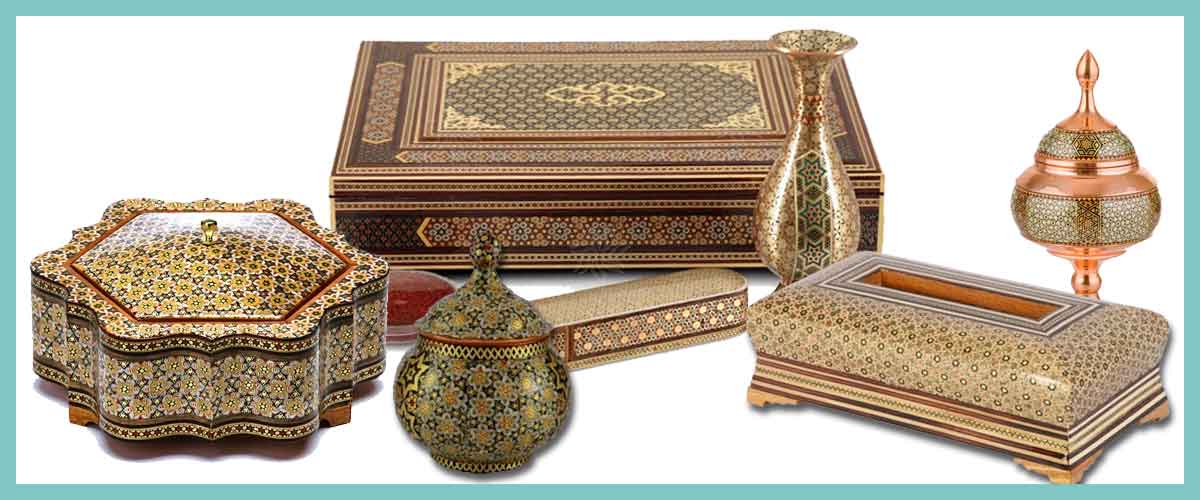
سُفالگَری
سُفالگری، هُنَرِ ساختِ ظُروف و اَشیا از خاکِ رُس است. ظُروفِ سُفالی از قَدیمی ترین ساخته هایِ دَستِ بَشر هستند. یافته هایی با بیش از 10000 سال قِدمَت در تَمَدُن هایِ بِینُ النَهرِین، ایران و غیره بَیانگرِ اَهَمیت و گُستردِگیِ این هُنر و مَحصولاتَش در زندگی بشر می باشند. قدیمی ترین چَرخِ سُفالگری که تا کُنون پیدا شده است، 5000 سال قِدمَت دارد و در شهرِ شوشِ ایران یافت شده است. از دیگر مَناطقِ باستانیِ ایران با یافته هایِ سُفالی می توان تَپه های سَیلکِ کاشان و یا تورنگ تَپه ی گُلستان را نام بُرد. امروزه، شَهر لاله جین هَمدان نیز به عُنوانِ شَهرِ جَهانیِ سُفال به ثَبت یونسکو درآمده است و کارگاه های سُنَتی و مُدرن در آن مَشغول به کار هستند.
شما هم اگر به صَنایعِ دَستی عَلاقه دارید نظراتِ خودتان درباره ی هُنرهایِ دَستی مَنطقه اتان یا تَجرُبه یِ خریدِ صَنایعِ دَستی در ایران را با ما به اِشتراک بِگُذارید. اگر کار هنری می کنید، برای ما درباره ی کارتان بنویسید و عکس بفرستید تا در سایت فارسیموند از آنها استفاده کنیم.
Pottery
Pottery is the art of making utensils and objects from clay. Clay pots are one the oldest objects which are made by human beings. The remnants of clay pots from 10 millennia ago in Mesopotamia, Iran, and other places show the importance and prevalence of this art in the life of human beings. The oldest pottery wheel from 5000 years ago was found in Shush, Iran. Other ancient places in Iran in which clay pots were found are Sialk Archeological Hills in Kashan and Torang Archeological Hills in Golestan. Moreover, Lalejin in Hamedan is registered by UNESCO as the world city of Pottery.
If you are interested in handicrafts, leave a comment for us and write about your region’s handicrafts or your experience of buying handicrafts in Iran. If you are an artist, tell us about your art and send us photos.

Why to learn Farsi ..? To help you learn Farsi, our experienced Online Farsi tutors in FarsiMonde provide you with the best online Farsi classes and offer you the best Farsi learning methods.


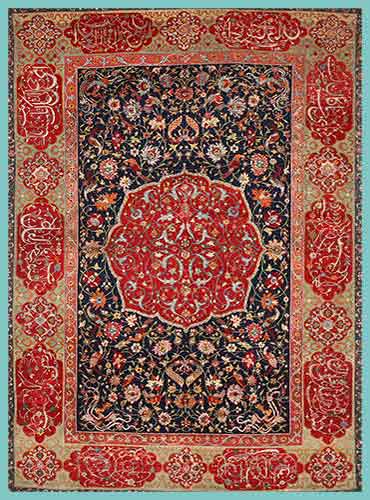
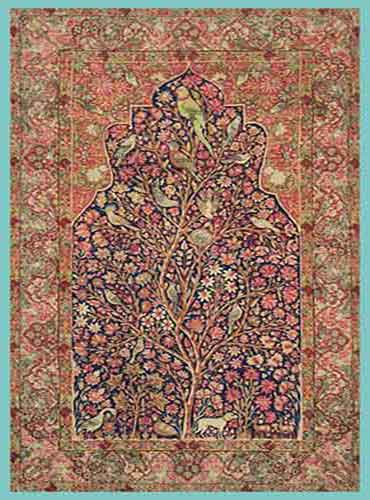
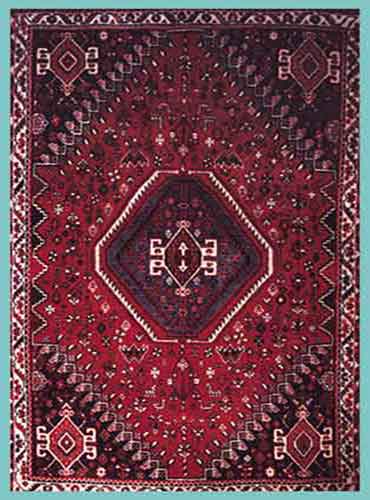
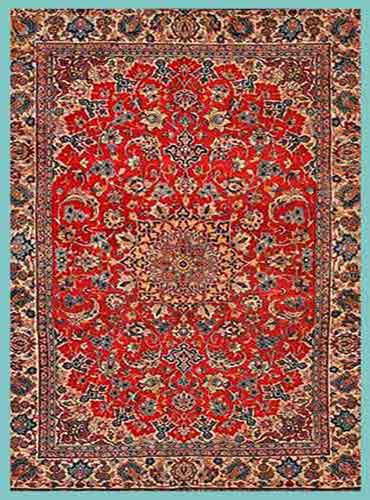


Leave A Comment